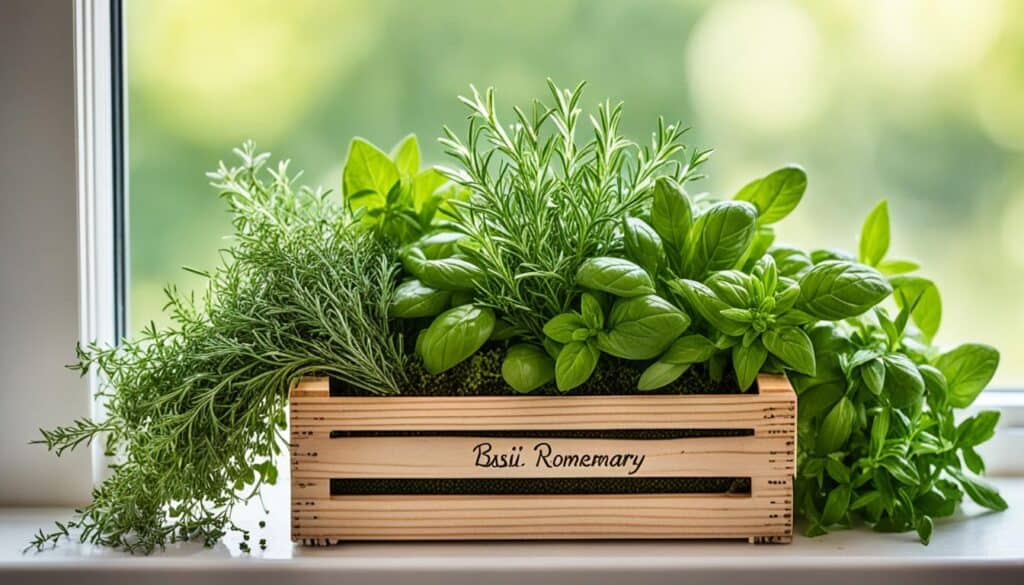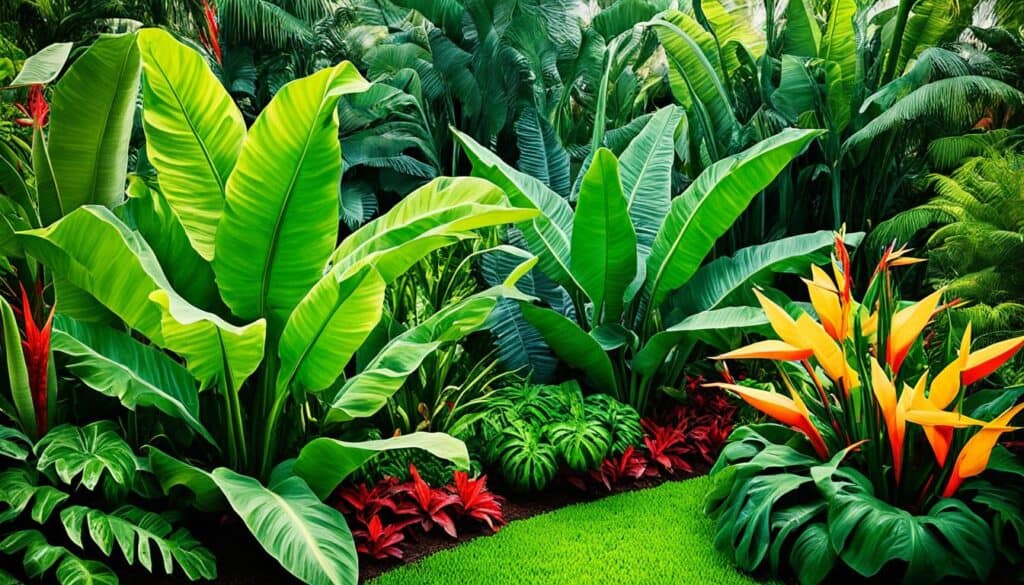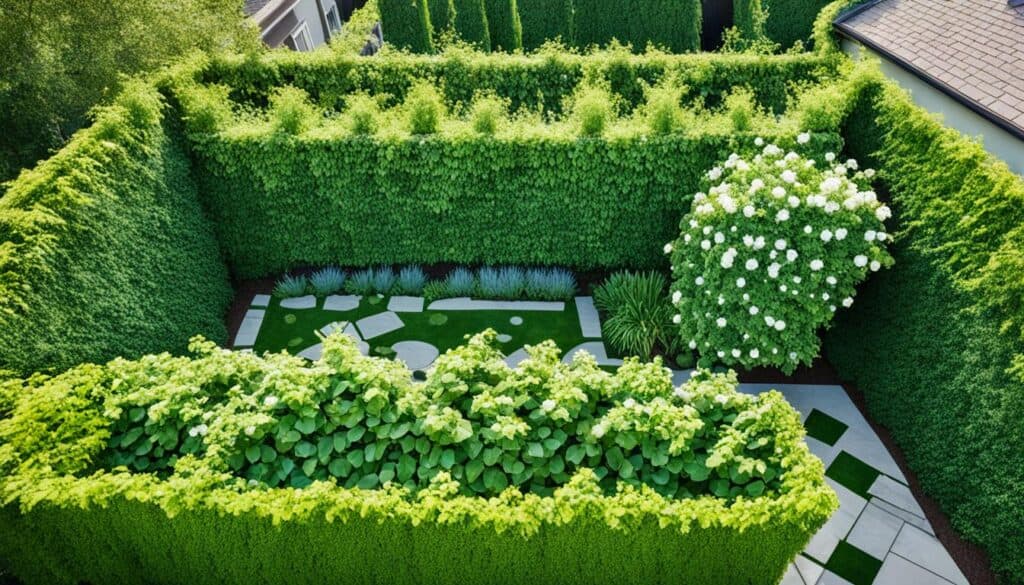If you’re looking to enjoy organic vegetables right from your backyard, then starting a vegetable garden is the way to go. Not only does it allow you to have complete control over the cultivation process, but it also provides you with the satisfaction of growing your own nutritious and delicious produce. With a few gardening tips and tricks, you can create a lush and thriving vegetable garden that will reward you with a bountiful harvest.
Key Takeaways:
- Starting your own vegetable garden allows you to enjoy homegrown and organic vegetables.
- You can have complete control over the cultivation process when you grow your own vegetables.
- With the right gardening techniques, you can create a lush and thriving vegetable garden.
- Enjoy the satisfaction of growing your own nutritious and delicious produce.
- Follow these tips and tricks to cultivate a bountiful harvest in your vegetable garden.
Start with Seed Starting
Seed starting is an inexpensive and rewarding technique for cultivating plants in your vegetable garden. With just a few simple steps, you can raise healthy seedlings that will later flourish in your garden beds. All it takes is potting soil, a suitable vessel or ground, water, and, of course, seeds.
Starting your plants from seeds is not only a cost-effective approach but also an excellent activity to involve kids in gardening. They will be delighted to witness the magical process of a tiny seed germinating, pushing through the soil, and transforming into a vibrant seedling.
Here is a quick guide to get you started with seed starting:
Gather Your Materials:
- Potting soil: Choose a high-quality soil mix specifically formulated for seed starting to ensure optimal growth.
- Vessel or ground: You can use seed trays, peat pots, or even repurpose eggshells or yogurt cups as containers. Alternatively, you can sow seeds directly into your garden beds by preparing a small furrow or hole.
- Water: Ensure you have a source of clean water to keep the soil moist throughout the germination process.
- Seeds: Select the vegetable seeds you want to grow in your garden. Choose varieties suited to your climate and personal preferences.
Sow Your Seeds:
- Fill your containers with potting soil, leaving a small space at the top.
- Plant the seeds according to the recommended depth provided on the seed packet.
- Gently tamp down the soil to ensure good seed-to-soil contact.
- Water the containers thoroughly, ensuring that the soil is moist but not soaking wet.
- Place your containers in a warm location with ample sunlight or under artificial grow lights.
Nurture Your Seedlings:
Keep a close eye on your seedlings as they emerge and grow. Ensure they receive adequate moisture by regularly checking the soil’s moisture level. Watering from below—by placing the containers in a tray of water—is often more effective than watering from above, as it promotes healthy root development.
As the seedlings grow, they may need thinning or transplanting into larger containers to ensure they have enough space to flourish. Gradually introduce them to outdoor conditions, a process known as hardening off, before transplanting them into your garden beds.
“The miracle of seed germination is a testament to the power and beauty of nature. Each seed holds the potential to transform into a thriving vegetable plant, ready to provide nourishment and joy.”
–Anonymous
By starting your plants from seeds, you have control over the entire process, from seed selection to harvest. It’s a gratifying experience that allows you to truly connect with the growth and development of your vegetable garden.
| Benefits of Seed Starting | Tips |
|---|---|
| Cost-effective | Choose heirloom or organic seeds for a sustainable garden |
| Wide variety of vegetable options | Start seeds indoors 6-8 weeks before the last frost date in your area |
| Opportunity for hands-on learning | Research the specific requirements of each vegetable seed for optimal germination |
| Full control over the growth process | Label your containers to keep track of different varieties |
Mulch Like a Pro
When it comes to maintaining a beautiful and productive vegetable garden, mulching is a practice that shouldn’t be overlooked. Not only does mulch provide an aesthetically pleasing appearance, but it also offers numerous benefits for your plants and soil.
Mulching is a simple and effective way to reduce weeding time by preventing weed growth around your garden plants, shrubs, and trees. By blocking out sunlight and hindering weed seed germination, mulch acts as a natural weed barrier and helps keep your garden beds clean and weed-free. This means less time spent pulling weeds and more time enjoying your thriving vegetable garden.
When it comes to choosing the right mulch for your vegetable garden, you have a variety of options. Some popular choices include shredded cedar bark, pine needles, grass clippings, gravel, or stone. These different types of mulches can add texture and visual interest to your garden while providing the weed-suppressing benefits.
It’s important to note that plant-based mulches, such as shredded cedar bark or grass clippings, will break down over time and enrich the soil with organic matter. To maintain the mulch layer’s effectiveness, it’s recommended to refresh it with a top layer every couple of years. This not only keeps your garden looking fresh but also continues to suppress weed growth and improve soil health.
Aside from weed control, mulching has additional advantages for your vegetable garden. It helps retain moisture in the soil, reducing the need for frequent watering during hot summer months, and promotes better water absorption, preventing soil erosion. Mulch also acts as an insulating layer, regulating soil temperature and protecting plant roots from extreme heat or cold.
To showcase the benefits of mulching in your vegetable garden, refer to the table below:
| Benefits of Mulching | Explanation |
|---|---|
| Reduced Weeding Time | Mulch prevents weed growth by blocking sunlight and hindering weed seed germination. |
| Improved Soil Moisture Retention | Mulch helps retain moisture in the soil, reducing the need for frequent watering. |
| Regulated Soil Temperature | Mulch acts as an insulating layer, protecting plant roots from extreme heat or cold. |
| Enhanced Soil Health | Organic mulches break down over time, enriching the soil with organic matter. |
As you can see, mulching is a valuable technique for maintaining a healthy and thriving vegetable garden. It not only saves you time on weeding but also improves the overall health and productivity of your plants. So go ahead, mulch like a pro, and enjoy a beautiful and low-maintenance vegetable garden.
Plant Fragrant Flowers and Herbs
Adding fragrant flowers and herbs to your vegetable garden not only enhances its beauty but also fills the air with delightful scents. Fragrance plays a central role in creating a sensory experience in the garden, captivating both your senses and the attention of beneficial pollinators. Here are some options to consider:
Perennial flowers:
Roses, peonies, and lilacs are renowned for their captivating fragrances. These timeless beauties not only add a touch of elegance to your garden but also fill the air with their sweet scents season after season.
Annuals in containers:
If you have limited space or want to enjoy the scent up close, consider planting fragrant annuals in containers. Heliotrope, petunia, and alyssum are excellent choices that will not only provide fragrance but also add vibrant colors to your garden.
Tropical vines:
If you’re looking to infuse fragrant scents into your porches or patios, tropical vines like jasmine can create a paradise-like atmosphere. These climbers produce an enchanting fragrance that perfumes the air with every breeze.
By incorporating fragrant flowers and herbs into your vegetable garden, you can turn it into a aromatic sanctuary that delights your senses and attracts beneficial pollinators. Whether through the timeless fragrance of roses and peonies or the exotic scents of tropical vines, the addition of these fragrant gems will surely elevate your gardening experience.
Grow a Container Herb Garden
If you don’t have space for a traditional vegetable garden, don’t worry! You can still enjoy the fresh flavors of herbs by growing a container herb garden. It’s a convenient and rewarding way to bring the taste of the garden right to your kitchen.
Herbs are incredibly versatile and easy to grow, making them perfect for containers. They can tolerate neglect, require minimal maintenance, and provide delicious edible leaves and flowers for your culinary creations.
When creating your container herb garden, consider your cooking preferences and the flavors you enjoy. You can create a mixed container combination of herbs from different cuisines:
- Mediterranean herbs: Basil, thyme, oregano
- Asian herbs: Cilantro, lemongrass, Thai basil
- French herbs: Parsley, tarragon, rosemary
| Herb | Sunlight | Watering | Growing Tips |
|---|---|---|---|
| Basil | Full Sun | Regular watering | Pinch off flower buds to encourage leaf growth |
| Thyme | Full Sun | Allow soil to dry slightly between waterings | Trim back annually to promote new growth |
| Oregano | Full Sun | Allow soil to dry slightly between waterings | Prune regularly to prevent leggy growth |
| Cilantro | Partial Sun | Keep soil consistently moist | Sow new seeds every few weeks for a continuous harvest |
| Lemongrass | Full Sun to Partial Shade | Regular watering | Harvest outer stalks and leave inner ones to continue growing |
| Thai Basil | Full Sun | Regular watering | Pinch off flower buds to promote bushy growth |
| Parsley | Partial Sun | Keep soil consistently moist | Trim outer leaves to encourage new growth |
| Tarragon | Partial Sun | Allow soil to dry slightly between waterings | Divide plants every 2-3 years to ensure vigor |
| Rosemary | Full Sun | Allow soil to dry between deep waterings | Prune regularly to maintain shape and prevent legginess |
Tip: Make sure your container has proper drainage to prevent waterlogging and use a well-draining potting mix specifically formulated for herbs.
With a container herb garden, you’ll always have fresh herbs at your fingertips, adding flavor and freshness to your favorite dishes. So get creative and start growing your own culinary garden in containers today!
Embrace the Beauty of Tropical Foliage
Bring the lush feeling of the tropics to your garden by incorporating leafy tropical foliage plants. Palms, Dracaena, and Sansevieria are excellent choices for shaded front porches or outdoor seating areas. These plants can create an instant jungle ambiance. You can enjoy them all summer and then bring them indoors during colder months. Foliage plants also help purify the air indoors.
Adding tropical foliage plants to your vegetable garden not only enhances its visual appeal but also introduces a sense of exotic charm. The vibrant leaves and unique shapes of tropical plants create a stunning focal point in any outdoor space.
One of the most popular choices for tropical foliage plants is the palm family. Palms come in various sizes and shapes, making them versatile for any garden setting. From towering fan palms to compact dwarf varieties, you can find a palm that suits your specific needs and space requirements. Palms thrive in shaded areas, making them perfect for front porches or outdoor seating areas.
Another stunning tropical foliage plant is the Dracaena. With its striking upright growth habit and colorful leaves, the Dracaena adds drama and elegance to any garden. You can choose from a wide range of Dracaena varieties, each offering a unique combination of leaf colors and patterns. These plants can tolerate both sun and shade, making them adaptable to different growing conditions.
The Sansevieria, also known as the snake plant or mother-in-law’s tongue, is another popular tropical foliage plant. With its tall, stiff leaves and architectural shape, the Sansevieria adds a modern and sculptural element to your garden. These plants are incredibly low-maintenance and can withstand neglect. The Sansevieria thrives in a wide range of light conditions, from bright indirect light to low-light environments.
When incorporating tropical foliage plants into your vegetable garden, consider their lighting requirements and space availability. Place them in areas with partial shade or filtered sunlight to mimic their natural habitat. Group different varieties together to create texture and interest. Combine palms, Dracaena, and Sansevieria with other ornamental plants, flowers, and vegetables to create a visually stunning and productive garden.
Explore the tropical foliage plants collection available at your local nursery or garden center. Bring home the beauty and allure of the tropics to your own vegetable garden.
Daily Garden Walk and Maintenance
As a diligent gardener, I know that daily maintenance is key to keeping a thriving vegetable garden. Taking a few minutes each day for a walk in your garden can make a world of difference. Not only does it allow you to enjoy the beauty of your plants, but it also helps you stay on top of any potential issues that may arise.
During your garden walk, keep a keen eye out for any signs of insect pests or diseases. Spotting these problems early on is crucial in preventing them from becoming major issues that can damage your vegetable garden. By promptly addressing pest infestations or disease outbreaks, you can implement appropriate measures to mitigate their impact and protect your precious plants.
While you stroll through your garden, don’t forget to deadhead any faded blooms you come across. Deadheading is the practice of removing spent flowers, and it serves two purposes. Firstly, it keeps your garden looking tidy and well-maintained. Secondly, and more importantly, deadheading encourages plants to produce more flowers, resulting in a more vibrant and beautiful garden.
Remember, a daily garden walk is not only about maintenance but also about connecting with nature and enjoying the fruits of your labor. Take a deep breath and take in the scents and sights of your vegetable garden—it’s a therapeutic and rewarding experience that nourishes the soul as well as the body.
By incorporating a daily garden walk and maintenance routine into your gardening regimen, you can ensure that your vegetable garden remains healthy and productive. Plus, you’ll have the opportunity to witness the growth and progress of your plants firsthand, which is incredibly satisfying.
Now that we’ve covered the importance of daily garden walks, let’s move on to the next section, where we’ll explore the benefits of incorporating native perennials into your vegetable garden.
Native Perennials for Easy Care
When it comes to creating a low-maintenance vegetable garden, incorporating native perennial plants is a smart choice. These plants are already adapted to the local climate, rainfall, and soil conditions, making them the ideal option for hassle-free gardening. Native perennials have evolved in the same area where you are planting them, which means they thrive better than other perennials. They require less care and are naturally more resistant to local pests and diseases.
By choosing native perennials for your vegetable garden, you can enjoy beautiful blooms and foliage without the need for constant attention. These plants have developed the ability to survive and thrive in your specific region, making them hardy and resilient. Not only will they add visual interest and diversity to your garden, but they will also attract native pollinators, creating a more balanced ecosystem.
Benefits of Native Perennials in your Vegetable Garden
Planting native perennials in your vegetable garden offers several advantages:
- Low Maintenance: Native perennials are well-suited to the local environment, requiring minimal care and maintenance.
- Water Efficiency: These plants have adapted to your region’s natural rainfall patterns and typically require less supplemental watering.
- Resilience: Native perennials have built-in defenses against local pests and diseases, reducing the need for chemical interventions.
- Ecosystem Support: By providing native plants, you create habitats and food sources for local wildlife, including beneficial insects and birds.
When selecting native perennials for your vegetable garden, consider factors such as sun exposure, soil type, and water availability. By choosing plants that are naturally suited to your garden’s conditions, you’ll create an environment where they can thrive and flourish.
Best Native Perennials for Vegetable Gardens
| Plant | Description |
|---|---|
| Milkweed | A favorite of monarch butterflies, milkweed adds beauty and supports pollinators. |
| Black-Eyed Susan | This vibrant, long-blooming flower attracts bees and butterflies. |
| Joe-Pye Weed | Tall, purple blooms that attract a variety of pollinators. |
| Coneflower | Drought-tolerant and loved by bees, coneflowers provide a splash of color. |
| Switchgrass | A native grass that adds texture and interest to the garden. |
These are just a few examples of native perennials that can complement your vegetable garden. Do some research and consult experts at local nurseries to discover more options that thrive in your area. By integrating native perennials into your garden, you’ll create a harmonious and sustainable space that both you and the environment will appreciate.
Use Trellises for Privacy and Beauty
Incorporating trellises into your vegetable garden not only adds an element of beauty but also provides practical benefits. A trellis can serve as a flowering vine screen or cover-up, offering privacy and hiding unsightly areas. It’s a versatile addition that can enhance the aesthetics of your garden while maximizing space.
Fast-Growing Annual Vines
If you’re looking for quick results, consider planting fast-growing annual vines on your trellis. Morning glory, sweet peas, and cup-and-saucer vine are excellent choices. These vigorous climbers will cover your trellis in lush foliage and vibrant blooms, creating a stunning vertical display in your vegetable garden. Their rapid growth and abundant flowers make them a popular choice for trellises.
Long-Lasting Beauty with Perennial Vines
If you prefer a more permanent and enduring beauty, opt for perennial vines. Clematis, honeysuckle, and trumpet creeper are fantastic options that will grace your trellis year after year. These perennial climbers offer large, showy blossoms in a variety of colors and are known for their longevity. They will bring elegance and charm to your vegetable garden, attracting beneficial pollinators and adding visual interest.
With trellises, you can create vertical elements that add privacy, hide unattractive views, and provide a gorgeous backdrop to your vegetable garden. Whether you choose fast-growing annual vines or long-lasting perennial climbers, trellises are an excellent way to maximize the beauty and space in your garden.
Replace Turf with Perennial Groundcovers
If you want to reduce lawn maintenance and enjoy more of your landscape, consider replacing struggling areas of turf with perennial groundcovers. These versatile plants not only add aesthetic appeal but also require less maintenance than traditional turf grass. They are an excellent choice for shaded spots or areas with shallow tree roots in your vegetable garden.
Perennial groundcovers like Ajuga, Vinca, and Pachysandra provide lush green foliage that can quickly fill in bare patches. They serve as a natural alternative to turf, creating a visually appealing carpet-like effect. These groundcovers are low-growing and can tolerate varying light conditions, making them suitable for different areas in your garden.
By replacing turf with perennial groundcovers, you can transform previously struggling areas into beautiful and low-maintenance spaces. The dense growth of these groundcovers also helps suppress weeds, reducing the need for frequent weeding.
Benefits of Perennial Groundcovers:
- Low-maintenance alternative to traditional turf grass
- Provides lush green foliage and visually appealing carpet-like effect
- Tolerates varying light conditions
- Suppresses weeds, reducing the need for frequent weeding
Here is an example of how perennial groundcovers can transform your vegetable garden:
| Before | After |
|---|---|
“Replacing struggling areas of turf with perennial groundcovers not only saves time and effort but also adds beauty to your vegetable garden.”
So, if you’re looking to minimize lawn maintenance and enhance the beauty of your vegetable garden, consider incorporating perennial groundcovers. They are a practical and visually appealing solution that will transform your landscape into a lush and low-maintenance haven.
Conclusion
Cultivating a lush and productive vegetable garden is achievable with the right strategies. By following these gardening tips, you can create a thriving vegetable garden filled with homegrown goodness. Starting your garden from seeds is not only cost-effective but also a great way to get kids involved in gardening. Remember to mulch around your plants to reduce weeding time and help retain moisture in the soil. Adding fragrant flowers and herbs not only adds beauty but also attracts beneficial pollinators to your garden.
If you don’t have space for a traditional garden, consider growing a container herb garden. It’s an easy and convenient way to enjoy fresh flavors in your cooking. Incorporating leafy tropical foliage plants can bring a touch of paradise to your outdoor spaces. Take a daily walk through your garden to keep an eye on any pests or diseases and deadhead faded blooms to encourage more flower production.
Using native perennials, trellises, and perennial groundcovers can minimize upkeep and provide privacy or hide unsightly areas. These gardening tips will help you create a beautiful and bountiful vegetable garden. So grab your gardening tools and get started! Happy gardening!










Leave a Reply